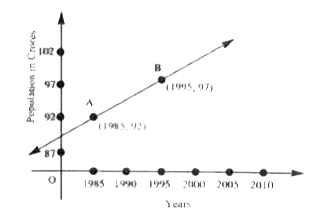If the four straight lines ax+by+p=0,ax+by+q=0,cx+dy+r=0 and cx+dy+s=0 form a prallelogram. Show that the area of the parallelogram so formed is
∣∣∣(p−q)(r−s)bc−ad∣∣∣Solution in Telugu
The correct Answer is:∣∣∣(p−q)(r−s)bc−ad∣∣∣
Step by step video, text & image solution for If the four straight lines ax+by+p=0, ax+by+q=0, cx+dy+r=0 and cx+dy+s=0 form a prallelogram. Show that the area of the parallelogram so formed is |((p-q)(r-s))/(bc-ad)| by Maths experts to help you in doubts & scoring excellent marks in Class 11 exams.
Updated on:21/07/2023Topper's Solved these Questions
- STRAIGHT LINESBOOK - AAKASH SERIESCHAPTER - STRAIGHT LINESEXERCISE - ADDITIONAL SOLVED EXAMPLES
12 Videos
- STRAIGHT LINESBOOK - AAKASH SERIESCHAPTER - STRAIGHT LINESEXERCISE - EXERCISE 3.1 (VERY SHORT ANSWER QUESTIONS)
11 Videos
- STRAIGHT LINESBOOK - AAKASH SERIESCHAPTER - STRAIGHT LINESEXERCISE - ADDITIONAL PRACTICE EXERCISE (LEVEL-II (ADVANCED) PRACTICE SHEET (ADDVANCED)) (Comprehension Type Questions)
6 Videos
- REVISION EXERCISEBOOK - AAKASH SERIESCHAPTER - REVISION EXERCISEEXERCISE - PROPERTIES OF TRIANGLES
57 Videos
- TANGENT AND NORMAL BOOK - AAKASH SERIESCHAPTER - TANGENT AND NORMAL EXERCISE - ADVANCED SUBJECTIVE TYPE QUESTIONS
48 Videos
Similar Questions
Consider the following population and year graph, find the slope of the line AB and using it, find what will be the population in the year 2010?

View SolutionFind the slope of the line whose inclination is
30∘
View SolutionLet A(0,0), B (5,0), C (5,3) and D(0,3) be the vertice of rectiangle ABCD , If P is a variable point lying inside the rectangle ABCD and d (P,L) denotes perpendicular distance of point P from line L
If ≤min{d(P,BC),d(P,CD),d(P,AD)}, then area of the region in which P lies is (in sq. units
View SolutionIn a triangle ABC, if A,B, C are in A.P and b:c =√3:√2, then
View SolutionFind the equations of tangent and normal to the curve
(xa)4+(yb)4=2 at (a,b)
View SolutionPoint P(p,0),Q(q,0),R(0,p),S(0,q) from parallelogram rhombus cyclic quadrilateral (d) none of these
View SolutionThe system of linear equations ax+by=0,cx+dy=0 has a non trivial solution if (A) ad+bc=0 (B) ad−bc=0 (C) ad−bc,0 (D) ad−bc.0
View SolutionIf the four straight lines ax+by+p=0,ax+by+q=0,cx+dy+r=0 and cx+dy+s=0 form a prallelogram. Show that the area of the parallelogram so formed is
∣∣∣(p−q)(r−s)bc−ad∣∣∣
View Solutionसारणिक के प्रगुण का प्रयोग कर दिखाइए :
∣∣ ∣ ∣∣0p−qp−rq−p0q−rr−pr−q0∣∣ ∣ ∣∣=0
View SolutionIf ad≠bc then the pair of linear equations ax+by=p and cx+dy=q has……….solutions.
View Solution|(0,p-q,p-r),(q-p,0,q-r),(r-p,r-q,0)|=
View SolutionIF the roots of ax2+cx+c=0 are in the ratio p:q then √[pq]+√[qp]=
View SolutionIf ad−bc≠0, then the area (in sq. units) of the parallelogram formed by the lines ax+by+2=0,ax+by+5=0,cx+dy+3=0andcx+dy+7=0 is
View SolutionPoint P(p,0),Q(q,0),R(0,p),S(0,q) form (a) parallelogram (b) rhombus (c) cyclic quadrilateral (d) none of these
View SolutionPoint P(p,0),Q(q,0),R(0,p),S(0,q) from.
View Solution
